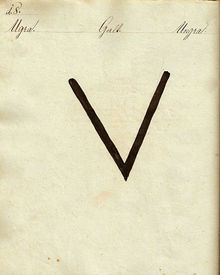Ungra
|
Ungra Galt Ugra |
||||
|
||||
| Basic data | ||||
|---|---|---|---|---|
| State : |
|
|||
| Historical region : | Transylvania | |||
| Circle : | Brașov | |||
| Coordinates : | 45 ° 59 ' N , 25 ° 16' E | |||
| Time zone : | EET ( UTC +2) | |||
| Height : | 450 m | |||
| Area : | 67.38 km² | |||
| Residents : | 1,949 (October 20, 2011) | |||
| Population density : | 29 inhabitants per km² | |||
| Postal code : | 507240 | |||
| Telephone code : | (+40) 02 68 | |||
| License plate : | BV | |||
| Structure and administration (as of 2016) | ||||
| Community type : | local community | |||
| Structure : | Ungra, Dăișoara | |||
| Mayor : | Traian Stanciu ( PSD ) | |||
| Postal address : | Strada Principală, no. 189 loc. Crizbav, jud. Brașov, RO-507240 |
|||
| Website : | ||||
Ungra (outdated Ugrona ; German Galt , Såksesch Gelt , Hungarian Ugra or Szászugra ) is a municipality in the Brașov district in Transylvania , Romania .
Geographical location
The municipality of Ungra is located in the southeast of the Transylvanian Basin in the historic Repser Ländchen . At the mouth of Homorods in Olt (Alt) and on the county road (drum Judeţean) (km 3 west of the DJ 131F E 60 ) is located at the foot of Galter Bergs elongated Ungra seven kilometers south of the town of Rupea (Reps) away . The Alt-Au here near Ungra is over three kilometers wide. The district capital Brașov (Kronstadt) is located about 60 kilometers southeast of Ungra.
The nearest train station is in Rupea, in the Rupea Gară settlement , on the Teiuş – Braşov railway line .
history
The place Ungra was founded by the Transylvanian Saxons and first mentioned in 1211. Archaeological finds on the site, however, suggest that the region was settled as far back as the Bronze Age . Numerous archaeological finds from the Neolithic Age that were found here in Ungra can be seen in the museums in Brașov and Sibiu .
In the year 262, a battle between the Gepids and the Goths is said to have taken place near the Roman bridge over the Olt next to the Hoghiz fort .
In the Kingdom of Hungary , the community was in the Repser See , afterwards in the Kőhalom (now Rupea ) district of the Greater Kokelburg County , then in the Târnava-Mare district and from 1950 in what is now the Brașov district.
population
The population of the municipality developed as follows:
| census | Ethnic composition | |||||||
|---|---|---|---|---|---|---|---|---|
| year | population | Romanians | Hungary | German | other | |||
| 1850 | 1,908 | 1,071 | - | 543 | 249 | |||
| 1941 | 2,634 | 1.310 | 90 | 612 | 622 | |||
| 1956 | 2,569 | 1,380 | 202 | 454 | 533 | |||
| 1992 | 1,987 | 674 | 53 | 110 | 1,150 | |||
| 2002 | 2,038 | 880 | 46 | 31 | 1,081 | |||
| 2011 | 1,949 | 1,666 | 28 | 28 | 227 (207 Roma) | |||
Since the official survey of 1850, the highest number of inhabitants and that of the Romanian Germans in 1941 have been determined in the area of today's municipality. The highest number of Magyars was registered in 1956 and that of Roma in 1992.
Attractions
- The Protestant fortified church built in the 13th century is a listed building. The basalt of the Roman fort of Hoghiz, which was once built as a basilica from red basalt cuboid, is now a 36-meter-long single-nave church. The aisles of the basilica were demolished in order to be able to build the battlement over the nave. In the 19th century, the weir system and a tower in the west were demolished due to damage from an earthquake and the portal in the west was exposed. One of the two lion heads on the portal is in the sacristy of the church and one in the Brukenthal Museum in Sibiu. The church is surrounded by a simple wall, the gate tower of which is in the southeast. A Roman cemetery with stone sarcophagi was found next to the community cemetery. There is a small village museum in the gate tower of the fortified church.
- The Romanian Orthodox Church Sf. Treime (Str. Principală nr. 7), built according to various sources in the 18th century or 1820, is a listed building.
Personalities
- Bucur Șchiopu (1911–1991), politician (1955–1965, Minister of Agriculture; 1965–1969, Minister of the Food Industry; 1970–1976, Romania's first ambassador to Canada)
Web links
- Ungra at ghidulprimariilor.ro
- Was valid at sevenbuerger.de
- Ungra on the Brașov Board of Directors website
Individual evidence
- ↑ 2011 census in Romania ( MS Excel ; 1.3 MB)
- ↑ a b c d Heinz Heltmann, Gustav Servatius (Ed.): Travel Guide Siebenbürgen. Kraft, Würzburg 1993, ISBN 3-8083-2019-2 .
- ↑ Information on the Ungras website , accessed on October 23, 2016 (Romanian).
- ↑ a b c d List of historical monuments of the Romanian Ministry of Culture, updated 2010 (PDF; 7.10 MB)
- ↑ Institute Of Archeology - Ungra at cimec.ro accessed on October 23, 2016 (Romanian)
- ↑ Census, last updated November 1, 2008 (Hungarian; PDF; 525 kB)
- ^ Image of the gate tower of the fortified church
- ↑ Information and pictures about Ungra at clujonline.com accessed on October 25, 2016 (Romanian)
- ↑ Information on the Orthodox Church at biserici.org accessed on October 23, 2016 (Romanian)
- ↑ Teodor Marian: People who wrote history, Bucur Șchiopu at arhiva.lumeasatului.ro, accessed on October 25, 2016 (Romanian)




